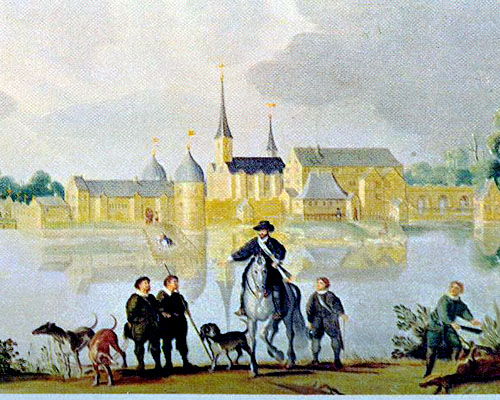| Jagt

| | I starten af 1700-tallet ejer kongen det meste af Nordsjælland, som fortrinsvis benyttes til jagtterræn og hesteopdræt. |
Kongens domæne
Efter reformationen i 1536 overtager kongemagten omfattende jordbesiddelser fra klostrene i Nordsjælland og i tiden herefter øges kronens jordejendom i området yderligere. Omkring 1546 køber kongen således 64 selvejerbønder ud og ved jordbytte med adelen lykkes det i anden halvdel af 1500-tallet kongemagten at skabe rådighed over det meste af Nordøstsjælland.
Kongens hovedinteresse i Nordsjælland var jagten, og størstedelen af landskabet benyttes som jagtterræn og græsningsarealer for kongens heste. Det dyrkede areal var derfor sparsomt og kronbøndernes hoveriarbejde bestod hovedsagelig i høslet, træfældning og ikke at forglemme bygge- og anlægsopgaver. I Frederik II.s tid opføres således Kronborg og Frederiksborg Slot og i 1584 anlægges den første såkaldte kongevej som forbandt de to slotte.

Nordsjælland | 
Kongens jord | 
Det første Frederiksborg | 
Kongevej i Nyrup Hegn | 
Kongeveje i Nordsjælland |
Vildtbaner og dyrehaver
I Frederikd.2.s tid påbegyndes arbejde med at indrette vildtbaner og afspærrede dyrehaver, f.eks. Lille Dyrehave, der omgav selve Frederiksborg Slot. Christian 4., der i sin tid ombygger Frederiksborg Slot, fortsætter arbejdet med at forbedre jagtterrænet med anlæggelsen af Store Dyrehave syd for Hillerød, som indhegnes med røde stakitter. Han udbygger ligeledes kongevejene sydover, så han kan komme hurtigt frem og tilbage imellem Frederiksborg og den voksende residensstad København.
Christian d. 5.(1670-1699)havde som kronprins i 1662-63 gæstet den franske solkonge Ludvig d.14.s hof og her stiftet bekendtskab med parforcejagten og ønskede nu at skabe betingelser for at bedrive denne jagtform i Nordsjælland. 1669 påbegyndes anlægget af den senere Jægersborg Dyrehave, som i 1670 udvides af Christian 5. til også at omfatte det nuværende Jægersborg Hegn. En engelsk parforce-jæger, Robert Badge, indkaldes og allerede i efteråret 1670 drives parforcejagt med engelske hunde, heste og jægere.

Lille Dyrehave | 
Store Dyrehave | 
Frederiksborg 1652 |
Jægersborg og Frederiksborg
I 1680, efter afslutningen af Skånske Krig, påbegynder kong Christian 5. en samlet reorganisering af jagtterrænet. Han indkalder to eksperter fra England og fra omkring år 1700 foreligger der planer over de allerede påbegyndte anlæg omkring Frederiksborg Slot og den sydlige del af Esrum sø. Jægerborg bliver, som navnet antyder, centrum for administration af jagten, men selve jagten foregår i hele Nordøstsjælland. Kongen bedrev alle mulige andre former for jagt, oprettede et falkoneri og arrangerede dyrekampe. I Lille Dyrehave ved Frederiksborg var der således løver, elefanter og rensdyr og i slottets værelser fugle og aber sammen med yndlingshundene.
Ofte tog jagten udgangspunkt fra Frederiksborg Slot, men der var også en jægergård i Nyrup udenfor Helsingør og kongen holdt også til på Østrup, hvor Fredensborg nu ligger. Jagten var som oftest et omfattende foretagende, som krævede store ressourcer. Til en klapjagt på Jægerspris i 1680 skulle 500 mand møde som klappere og medbringe kost til 5-6 dage.
Parforcejagten
Parforcejagt foregik til hest, hvor jægerne ad de anlagte stier jagtede et stykke vildt med hunde, som sluttelig stillede vildtet, så kongen eller en af ham udpeget kunne få fornøjelsen af at aflive dyret med kniv (hirschfänger). Ømosen i nærheden af Gurre var et fast tilholdssted for de store hjorte og ofte udvalgte kongen her det pågældende dyr. 1720 var der 140 hunde og 50 hvalpe knyttet til parforcejagten. Jagthundene skulle indøves og det forgik på Jægergården i Nyrup.
Jagten varede som oftest flere timer og havde karakter af selskabelig begivenhed, hvor damerne fra åbne vogne, eller pavilloner kunne iagttage skuespillet med den enevældige monark som hovedrolleindehaver. Den englelske iagttager Robert Molesworth har beskrevet afslutningen på en jagt i Christian 5.s tid.

Parforcejagt | 
Parforcejagt | 
Parforcejagt |
Hoffets vildtforbrug
Normalt gik alt vildtet fra de kongelige jagtrevirer til den kongelige husholdning og hoffets vildtforbrug var stort. I 1680 anvendtes 56 retter vildt om ugen. |